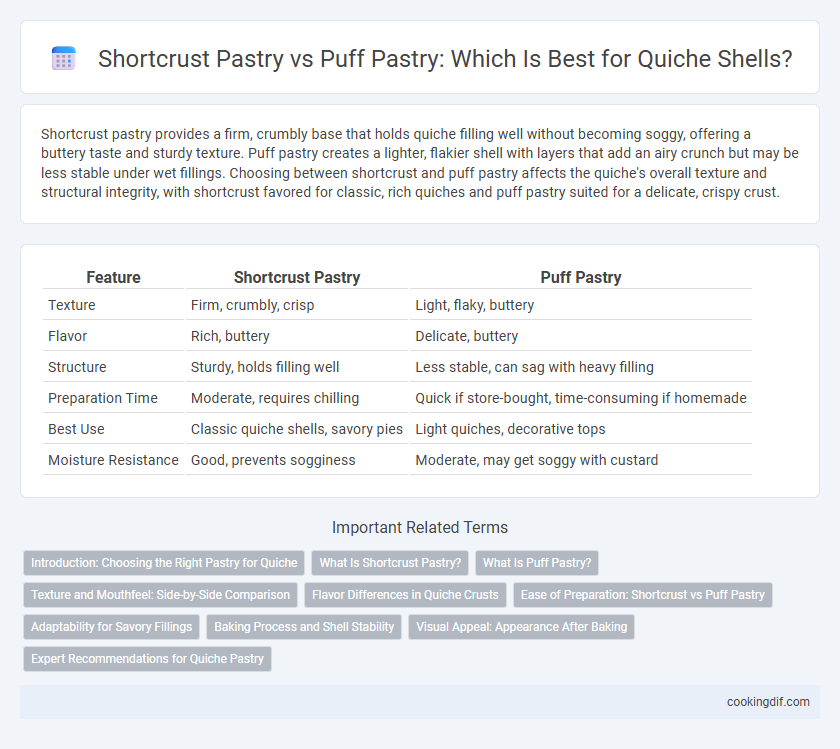Shortcrust pastry provides a firm, crumbly base that holds quiche filling well without becoming soggy, offering a buttery taste and sturdy texture. Puff pastry creates a lighter, flakier shell with layers that add an airy crunch but may be less stable under wet fillings. Choosing between shortcrust and puff pastry affects the quiche's overall texture and structural integrity, with shortcrust favored for classic, rich quiches and puff pastry suited for a delicate, crispy crust.
Table of Comparison
| Feature | Shortcrust Pastry | Puff Pastry |
|---|---|---|
| Texture | Firm, crumbly, crisp | Light, flaky, buttery |
| Flavor | Rich, buttery | Delicate, buttery |
| Structure | Sturdy, holds filling well | Less stable, can sag with heavy filling |
| Preparation Time | Moderate, requires chilling | Quick if store-bought, time-consuming if homemade |
| Best Use | Classic quiche shells, savory pies | Light quiches, decorative tops |
| Moisture Resistance | Good, prevents sogginess | Moderate, may get soggy with custard |
Introduction: Choosing the Right Pastry for Quiche
Shortcrust pastry offers a sturdy, crumbly base that holds rich fillings without becoming soggy, making it ideal for quiche shells. Puff pastry provides a light, flaky texture that adds a delicate crunch but may be less stable with moist ingredients. Selecting shortcrust or puff pastry depends on the desired balance between structural integrity and flaky texture in the quiche.
What Is Shortcrust Pastry?
Shortcrust pastry is a type of dough made from flour, fat (usually butter), and water, known for its crumbly, tender texture ideal for quiche shells. Unlike puff pastry, which is layered and flaky, shortcrust pastry provides a sturdy base that holds the filling without becoming soggy. Its rich, buttery flavor and firm structure make it the preferred choice for classic quiche recipes, ensuring a balanced crust-to-filling ratio.
What Is Puff Pastry?
Puff pastry is a laminated dough consisting of multiple layers of butter and dough, which creates a flaky, airy texture when baked. Unlike shortcrust pastry, which is crumbly and dense, puff pastry offers a light and crisp shell that contrasts with the creamy filling of a quiche. This makes puff pastry ideal for those seeking a delicate, buttery base that enhances the overall mouthfeel of the quiche.
Texture and Mouthfeel: Side-by-Side Comparison
Shortcrust pastry offers a firm, crumbly texture that provides a sturdy base for quiche, creating a buttery and dense mouthfeel that contrasts nicely with creamy fillings. Puff pastry delivers a light, flaky, and layered texture that enhances the quiche with crispness and an airy, delicate bite. Choosing shortcrust yields a more substantial eating experience, while puff pastry emphasizes crispness and a tender, melt-in-the-mouth sensation.
Flavor Differences in Quiche Crusts
Shortcrust pastry delivers a rich, buttery base with a firm texture that enhances the savory flavors of quiche fillings by providing a subtle, crumbly contrast. Puff pastry offers a lighter, flaky shell with layers that introduce a delicate crispness and a slightly sweet finish, balancing richer ingredients like cheese or bacon. The choice between shortcrust and puff pastry significantly influences the overall flavor profile and mouthfeel of the quiche, catering to different taste preferences and culinary styles.
Ease of Preparation: Shortcrust vs Puff Pastry
Shortcrust pastry offers greater ease of preparation for quiche shells due to its straightforward mixing and resting process, which requires minimal handling and fewer steps compared to puff pastry. Puff pastry demands meticulous folding and chilling to develop its signature layers, making it more time-consuming and labor-intensive. Home cooks often prefer shortcrust for its simplicity and reliable texture, ensuring a tender, crumbly base without extensive preparation.
Adaptability for Savory Fillings
Shortcrust pastry offers a sturdy, crumbly texture that holds rich, savory quiche fillings without becoming soggy, making it ideal for custard-based mixtures with cheese, meat, or vegetables. Puff pastry provides a light, flaky shell that adds a delicate crunch and visual appeal but can be less stable with moist ingredients, potentially compromising structure. For adaptability in savory quiches, shortcrust pastry is preferred due to its balance of durability and flavor absorption.
Baking Process and Shell Stability
Shortcrust pastry for quiche creates a sturdy, crumbly shell that withstands the wet filling during baking without becoming soggy, offering excellent structural support. Puff pastry, by contrast, produces a lighter, flakier crust but can lose stability due to its multiple butter layers, leading to potential shrinkage or sogginess as moisture from the filling seeps in. Choosing shortcrust enhances shell durability and ensures a firm base, while puff pastry prioritizes texture over long-term stability in quiche baking.
Visual Appeal: Appearance After Baking
Shortcrust pastry for quiche provides a firm, crumbly texture with a golden-brown, matte finish that highlights the rich filling, offering a classic and rustic visual appeal. Puff pastry creates a flaky, layered crust that puffs up during baking, resulting in a light, airy shell with a glossy, golden surface and distinct, delicate layers. The choice between shortcrust and puff pastry significantly impacts the quiche's overall presentation, with shortcrust emphasizing sturdiness and puff pastry showcasing elegance and texture contrast.
Expert Recommendations for Quiche Pastry
Experts recommend shortcrust pastry for quiche shells due to its sturdy, crumbly texture that holds fillings well without becoming soggy. Puff pastry, while lighter and flakier, may not provide the same structural support, often resulting in a less stable base for rich quiche fillings. For optimal balance between crispness and integrity, professional bakers favor shortcrust pastry when preparing classic quiches.
Shortcrust pastry vs puff pastry for quiche shell Infographic

 cookingdif.com
cookingdif.com